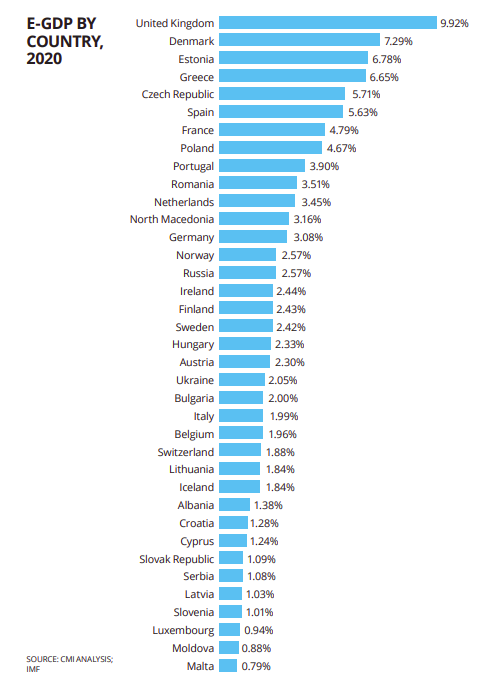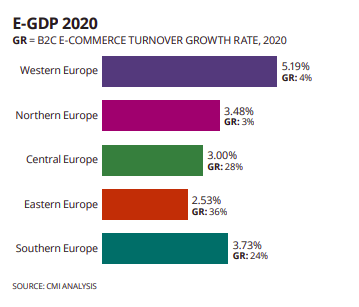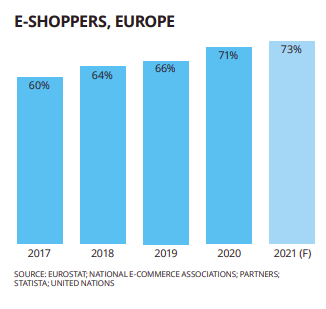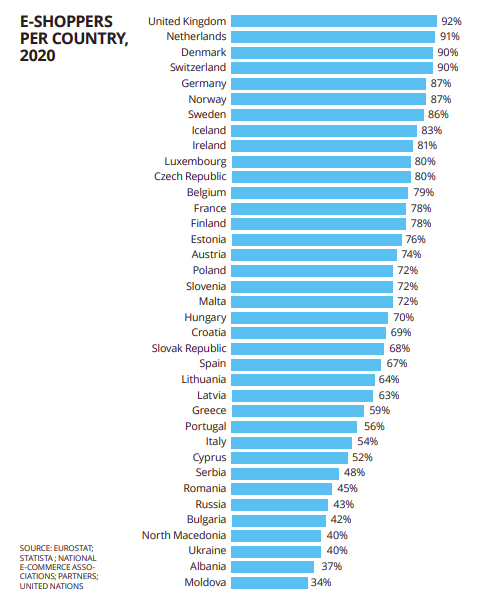e-GDP – the impact of e-commerce on the European economy
- 12 November 2021
E-commerce has become a vital part of the European economy. Buying online is now more natural to some customers than standing in queues in physical stores. The recently published report “2021 European E-commerce Report”, executed by Amsterdam University of Applied Sciences and Centre of Market Insights, examines the role of e-commerce by such measures as e-GDP and the percent of e-shoppers in different societies. We’ve analyzed these statistics to answer a crucial question: how far are we with e-commerce development and where are we heading?
e-GDP – what is it?
e-GDP reflects the share of GDP that is generated by e-commerce. The higher the number, the more important online trade is in a certain country.
How does this parameter look like in Europe in general?

Source: Lone, S., Harboul, N. & Weltevreden, J.W.J. (2021). 2021 European E-commerce Report.
As shown in the graph above, the share of e-commerce in the European economy was 4.3% in 2020 and is projected to account for 4.6% in 2021. As a comparison, the spending on defense in Europe amounted to 1.2 % of GDP in 2019.
The level of e-GDP can vary significantly between European countries. As shown below, in the UK it constitutes almost one tenth of the GDP while in such countries as Malta, Moldova or Luxembourg e-GDP doesn’t exceed 1%:

Source: Lone, S., Harboul, N. & Weltevreden, J.W.J. (2021). 2021 European E-commerce Report.
The level of e-GDP shows how important e-commerce is in comparison to other sectors. In such countries as the UK, Denmark and Estonia, shopping online plays an important role in the economy.
To get a broader view, you can analyze the data for the European regions. In addition, you can check how different regions grew in terms of e-commerce:

Source: Lone, S., Harboul, N. & Weltevreden, J.W.J. (2021). 2021 European E-commerce Report.
On average, e-commerce plays the most important role in the West European countries and the smallest one – in Eastern Europe. On the other hand, the growth rate in the e-commerce market turnover is almost the opposite. In 2020, the e-commerce market in Eastern Europe grew by as much as 36% while in Western Europe – “only” by 4%. It shows that the importance of e-commerce can grow considerably in the next few years.
E-shoppers in Europe – how many customers shop online?
Understanding customers’ behavior is key to understanding what drives certain trends. In our article Where do online shoppers look for product inspiration? Best ways to drive traffic to your online store, we have analyzed the most important websites on which customers look for product inspiration and best prices. “2021 European E-commerce report” enables to understand:
- What percentage of customers buy online in different countries,
- How often they make purchases.
The results are as follows:

Source: Lone, S., Harboul, N. & Weltevreden, J.W.J. (2021). 2021 European E-commerce Report.
The percentage of online shoppers grew from 60% in 2017 to 71% in 2021. Of course, the exact number depends on the country. In Moldova it’s still only 34% while in the UK almost everyone (92%) shops online:

Source: Lone, S., Harboul, N. & Weltevreden, J.W.J. (2021). 2021 European E-commerce Report.
How often do customers shop online?

Source: Lone, S., Harboul, N. & Weltevreden, J.W.J. (2021). 2021 European E-commerce Report.
The UK is again the leader, with 47% having done at least 6 online purchases within the last 3 months. In such countries as North Macedonia, Bulgaria or Romania the share of such customers is only 2%.
Marketplaces and price comparison websites in Europe
The growth of e-commerce is highly correlated with the growth of marketplaces. Which ones offer the lowest prices? On which ones is the competition the fiercest?
You can get a good overview based on the electronics and household appliances by reading our report: